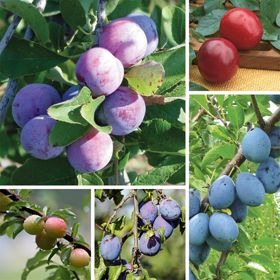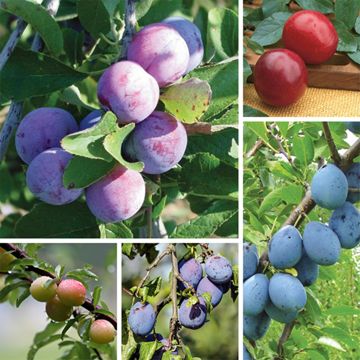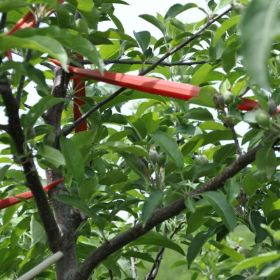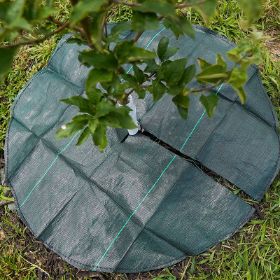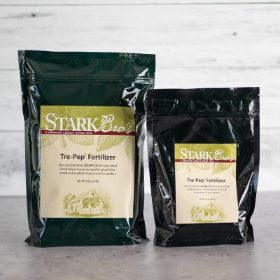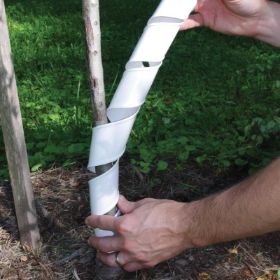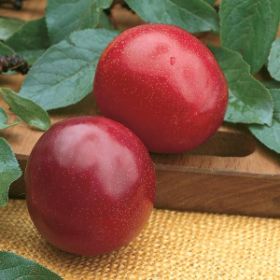5-N-1 Plum Tree
Description
Grow an assortment of plums on a single tree with our 5-N-1 multi-grafted Plum Tree! Grow both European and Japanese varieties including Burbank, Damson, Mt. Royal, Santa Rosa, and Stanely Plums.
Here is a little about each stone fruit variety grafted onto the tree:
Burbank
Developed by the “Wizard of Horticulture”, Luther Burbank. This winning Japanese-type plum almost has the color of a nectarine, with red blushing over a yellow background, with golden-orange flesh that is sweet and quite juicy. Burbank Plums have dramatic spring blooms are pristine white against dark green foliage.
A hardy tree that is easy to grow and produces a large crop for fresh eating, fruit tarts, jams, and jellies. Introduced in 1897 by the American Pomological Society, and named in honor of Burbank for his exemplary work with plum crosses. Ripens in mid-July.
Damson
Damson plums have a distinctive, rich flavor. The Damson Plum Tree bears consistently heavy crops of heirloom plums. The clingstone fruit is juicy and delightfully tangy. Try it in homemade jams and jellies and you will never settle for another plum’s preserves.
This plum is vigorous and hardy. Originates from Shropshire, England and was introduced to America in the late 1800s. Damson plums ripen in August.
Mount Royal
The Mount Royal Plum Tree is a European plum variety that produces small to medium fruits that have blue skin and sweet yellow-green flesh. The plums are round, unlike most prune plums which are oval in shape.
Mount Royal has dark green foliage throughout the season with leaves that turn yellow in fall. The flowers are white, showy, fragrant, and bloom in the spring. Blue drupes are ripe in August and are sweet and tender. They can be eaten fresh, dried, or in baked goods.
This heirloom plum variety that originated from Canada is extremely cold-hardy. Mount Royal Plum Trees are known for producing very heavy yields, even in cooler climates.
Santa Rosa
A favorite of home gardeners and farmers’ markets, the Santa Rosa plum, was introduced in 1906 by famed horticulturist, Luther Burbank, out of his home in Santa Rosa, California.
It is known for its sweet, slightly tart taste, and deep purple red color. This variety typically takes less years to begin bearing fruit than other plums. This Japanese plum variety makes a stunning ornamental tree with its showy, pinkish-white blossoms in the spring.
The skin of the plum is thin, and its yellow flesh clings tightly to the pit. Plums are good sources of fiber and high in vitamins A, C, and K. Due to its dark red coloring, the Santa Rosa plum is high in antioxidants. For preservation, plums can be canned, made into jam, or dehydrated into prunes.
Stanley
The Stanley Prune Plum Tree is a consistent producer of beautiful, easy-to-grow plums – setting the standard for all plum varieties. Now one of the most popular European plums, the Stanley was developed in Geneva in 1926 at the New York State Agricultural Experiment Station, as part of Cornell University.
Beautiful blooms in the spring lead to an abundant crop of classic, oval-shaped fruits with deep blue-purple skin and sweet yellow flesh with a hint of green. The flesh is firm and does not cling to the stone. Stanley Plum Prunes ripen in early September. The fruit is tender with high sugar content, great for eating fresh, and ideal for drying and baking.
Plant this 5-in-one plum tree in well-drained soil that is amended with good organic matter, and you will be rewarded with bushels of juicy plums. A consistent producer, this self-fertile tree is a must-have addition to your home orchard or edible landscape.
This multi-budded/ multi-grafted tree is self-pollinating.
Characteristics
| Hardiness Zone Range | 5 - 7 |
| Pollination | Self-Pollinating |
| Shade/Sun | Full Sun |
| Soil Composition | Loamy |
| Soil Moisture | Well Drained |
| Soil pH Level | 6.0 - 7.0 |
| Years to Bear | 3 - 6 |
Zone Compatibility
Pollination
This variety is self pollinating.
Tools & Supplies
Planting & Care
Learn all about how to grow plum trees in The Growing Guide. An entire section of our website dedicated to your growing success.



